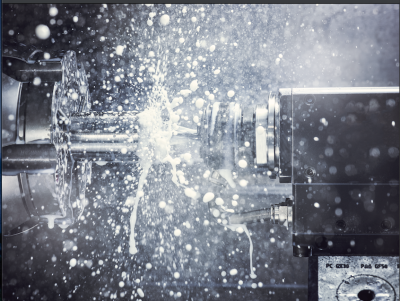
REGO-FIX USA has announced the extension of its reCool® line of coolant-through systems for live tooling on CNC lathes with reCool ERAX. Designed for driven tools with externally threaded nuts, this highly productive toolholding solution gives conventional lathes coolant-through capabilities in minutes with minimal loss (approx 10mm) of machining range or additional interference.
First developed as a space-saving solution for use with REGO-FIX floating chucks, ERA holders such as the ERA Zero-Z® and other ER collet holders with externally threaded nuts, the Hi-Q®/ERAX is ideal for maximizing the range of turning machines and minimizing the interference contour for larger parts and tighter machining envelopes. With reCool, driven tools and turning machines can easily be retrofitted for coolant- through functionality, enabling substantial improvements in tool life and productivity.
The reCool ERAX uses the patented reCool design to deliver coolant with a maximum pressure of 1,450 psi in live tooling applications with speeds up to 12,000 rpm. Equally well suited for emulsion and oil coolants, the system is currently available for ER collet sizes 16, 20, 25 and 32 to handle tools between 3-20 mm in diameter. Both through-tool coolant and peripheral cooling are possible using REGO-FIX DS/ER sealing disks and KS/ER coolant flush disks, respectively.
An affordable low-maintenance way to retrofit static or driven tooling systems with internal coolant capabilities, reCool makes process optimization simple. Reduced production time per piece, superior chip removal and compatibility with the wide range of REGO-FIX ER collets enable manufacturers to improve the performance of nearly any modern lathe. To learn more, take advantage of a free four-week trial of reCool at us.rego-fix.com/en/solutions/recool-er.
Contact Details
Related Glossary Terms
- collet
collet
Flexible-sided device that secures a tool or workpiece. Similar in function to a chuck, but can accommodate only a narrow size range. Typically provides greater gripping force and precision than a chuck. See chuck.
- computer numerical control ( CNC)
computer numerical control ( CNC)
Microprocessor-based controller dedicated to a machine tool that permits the creation or modification of parts. Programmed numerical control activates the machine’s servos and spindle drives and controls the various machining operations. See DNC, direct numerical control; NC, numerical control.
- coolant
coolant
Fluid that reduces temperature buildup at the tool/workpiece interface during machining. Normally takes the form of a liquid such as soluble or chemical mixtures (semisynthetic, synthetic) but can be pressurized air or other gas. Because of water’s ability to absorb great quantities of heat, it is widely used as a coolant and vehicle for various cutting compounds, with the water-to-compound ratio varying with the machining task. See cutting fluid; semisynthetic cutting fluid; soluble-oil cutting fluid; synthetic cutting fluid.
- emulsion
emulsion
Suspension of one liquid in another, such as oil in water.
- lathe
lathe
Turning machine capable of sawing, milling, grinding, gear-cutting, drilling, reaming, boring, threading, facing, chamfering, grooving, knurling, spinning, parting, necking, taper-cutting, and cam- and eccentric-cutting, as well as step- and straight-turning. Comes in a variety of forms, ranging from manual to semiautomatic to fully automatic, with major types being engine lathes, turning and contouring lathes, turret lathes and numerical-control lathes. The engine lathe consists of a headstock and spindle, tailstock, bed, carriage (complete with apron) and cross slides. Features include gear- (speed) and feed-selector levers, toolpost, compound rest, lead screw and reversing lead screw, threading dial and rapid-traverse lever. Special lathe types include through-the-spindle, camshaft and crankshaft, brake drum and rotor, spinning and gun-barrel machines. Toolroom and bench lathes are used for precision work; the former for tool-and-die work and similar tasks, the latter for small workpieces (instruments, watches), normally without a power feed. Models are typically designated according to their “swing,” or the largest-diameter workpiece that can be rotated; bed length, or the distance between centers; and horsepower generated. See turning machine.
- turning
turning
Workpiece is held in a chuck, mounted on a face plate or secured between centers and rotated while a cutting tool, normally a single-point tool, is fed into it along its periphery or across its end or face. Takes the form of straight turning (cutting along the periphery of the workpiece); taper turning (creating a taper); step turning (turning different-size diameters on the same work); chamfering (beveling an edge or shoulder); facing (cutting on an end); turning threads (usually external but can be internal); roughing (high-volume metal removal); and finishing (final light cuts). Performed on lathes, turning centers, chucking machines, automatic screw machines and similar machines.

